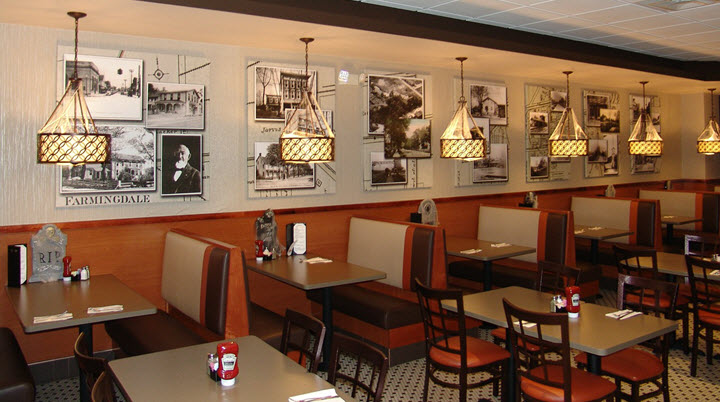
There are many motivations behind why people start restaurants.
Maybe you love to cook, or you bring a new concept to the table, or you have an entrepreneurial spirit and the restaurant industry seems like a good place to invest.
What other restaurant owners (including you?) soon realize is that running a restaurant is not as simple and inspiring as they thought it would be. It’s often much more work than they imagined and much less profit.
The margins of owning a restaurant typically hover around three percent, and that’s only after the restaurant has an established presence in its community. The first couple of years, most restaurant owners do not make a profit.
We talk with hundreds of restaurant owners every month. In this post I’ll share with you what they say about getting through the first year, and beyond.
The reason why many restaurants fail is because their owners and operators don’t take into account the primary factor for their establishment’s success: running it as a business. The most successful restaurants and restaurant groups are fastidious when it comes to understanding their spending and their sales. Business-minded managers can tell you how much a filet of salmon or a cut of beef in their stockroom will set them back, to the penny.
These business-minded managers understand the ebb and flow of money to their restaurants, which helps them evaluate ways to cut waste and be more efficient.
The Power of Simple Marketing
If you’re running your restaurant as business, you’re always on the lookout for ways to become more profitable. Drawing in more customers is essential to a rising bottom line, and restaurant marketing is essential to bringing in more customers.
As a restaurant operator or manager, you don’t have extra time or money to devote to complicated, intensive marketing campaigns. Instead, you can leverage a few simple, inexpensive tools to create a significant impact with your marketing.
Websites
You probably have a website to share information about your restaurant’s operating hours, what dishes you offer, and what people are saying about you. But that’s not enough! In order for your website to be found online, it must have search engine optimization (SEO) value, and it needs to be mobile-friendly.
Essentially, this means making changes on the backend of your website so search engines will show your restaurant to more people. So how do you add SEO to your site? Most website publishing tools come with built-in SEO tools. If you don’t know how to locate yours, search the help center for pointers.
The building block of SEO is a keyword. This is a word or phrase that most describes what your website is, e.g. New York City pizza. The more specific you can get with your keyword phrase, the better. You should then use this keyword to build a short description that will appear under your restaurant name in search engines (meta description), as well as add the keyword to the copy on your website.
Email Marketing
Your email list is one of the most valuable assets you have in your marketing arsenal. It’s free to collect email addresses, it’s cheap to send emails, and the ROI is $40 for every $1 spent. But to make it effective, you must get a lot of opens and clicks. Here are tips for doing just that:
1. Create an irresistible subject line. You need to get your subscribers to open your email, so the subject line is one of the most important parts to get right. Try using emojis so your subject line stands out in the inbox. Or make it just a few words long. Employ a joke or a well-known saying. Test different types of subject lines until you hit on a formula that works for your audience.
2. Make it mobile friendly. More email is opened on a cell phone today than on a computer. If you want your emails to be seen, they need to be readable – and look really good – on a mobile phone. Most email service providers have mobile-friendly email templates, but you still need to cut back on copy (eliminates too much scrolling on a mobile device) and make sure you include crisp images (to draw in your readers).
3. Use call-to-action (CTA) buttons. Tell people exactly what you want them to do by including a CTA button in every email. Send readers to your website to download a coupon or to Yelp to leave a positive review. It seems simplistic, but people need a direct line of communication from you. They get hundreds of emails a day, so they need to know right away what you are asking of them. You can do that with a CTA button.
Social Media
There are so many social media networks restaurants can use today to market their business and create community engagement. But if you don’t take into account the nuances of each channel, well… you’re doing it wrong.
First, size your images correctly. There’s nothing more off-putting than seeing someone’s head cut off in a photo because you didn’t size it correctly for Twitter’s post dimensions. You can use an easy and free tool such as Canva to create stunning, correctly-sized images for social media.
Speak your customer’s language. If you’re an upscale steakhouse in NYC, your social media posts should sound a lot different than a taco joint in La Jolla, CA, and vice versa. Use relevant hashtags for your type of restaurant and your location on Twitter and Pinterest. Hashtags act as ways for people to find you on both of these sites, sort of like keywords do for your website.
Finally, understand that social media isn’t all about you. Social media is an avenue for listening to and talking to your customers. Share stories and information about your community and the industry in general. It’s great to use social media to promote your restaurant, but make sure the conversation goes two ways.
Understanding Food Spend
To run a successful restaurant, conscientious operators know how much they’re spending and how much they’re making in sales on a basic level.
Typically, food spend should make up no more than 28-35 percent of a restaurant’s budget during a given month.
At any time, you should know what ingredients you’re ordering and how much you’re spending on each category, as well as on high-priced items. It’s not uncommon for suppliers to vary prices on items from week to week, which is why you need to pay close attention to item and category cost trends on a weekly basis.
Honing in on these numbers has additional benefits, too. First, you receive an overall perspective about the items your restaurant orders the most and can negotiate lower prices on these items to save money. You can also use this evaluation to understand the prices other viable suppliers offer for the same ingredients. This allows you to order from whichever supplier offers the lowest price from week to week, ensuring you always get the best deal.
Waste Not, Want Not
Cutting back on waste creates efficiency and saves restaurants money. This means putting processes in place that everyone on staff, not just management, follows.
One way to reduce waste is during inventory counting and valuation time. The responsibility for this task typically doesn’t fall on just one person’s shoulders. This is why it’s important to have a routine in place for whoever does it. Best practices include:
- Moving older items to the front to be used first, while newer items are placed back-of-shelf.
- Taking stock of items going bad faster than they can be used. Either:
- Make a note to order less of that item in the future
- Incorporate more of this item into the menu
Another area where it’s possible to reduce waste is scheduling shifts. Labor costs make up a significant chunk of a restaurant’s budget, and with the possible minimum wage hike, you could be looking at spending more than they can pull in. You need to track when the restaurant gets busiest by day and time to then schedule extra staff for when it’s busy and less staff for slower times of day.
In addition, when you provide staff with technology that helps them do their jobs more efficiently, you don’t have to hire as many bodies per shift.
Front-of-house and back-of-house technology is changing the way restaurants operate more efficiently. For the front-of-house, technology such as on-table ordering is reducing the amount of work waitstaff have to do. And back-of-house technology is emerging as a front-runner for simplifying restaurant operations, saving owners and operators significant time and money they can re-invest.
Work Hard & Work Smart
Despite the economy bouncing back, 60 percent of restaurants fail their first year, and 80 percent go under in five years. Most of the time, these restaurants shut their doors because operators and owners don’t embrace the business side of their passions.
If operators want to succeed, they must be realistic and work hard to manage their money wisely. As with any other business venture, a restaurant needs to bring in more money than it spends. Keeping an eye on cost by item and category, reducing waste, and employing no-brainer marketing techniques is a sure way to safeguard against a restaurant becoming just another statistic.






